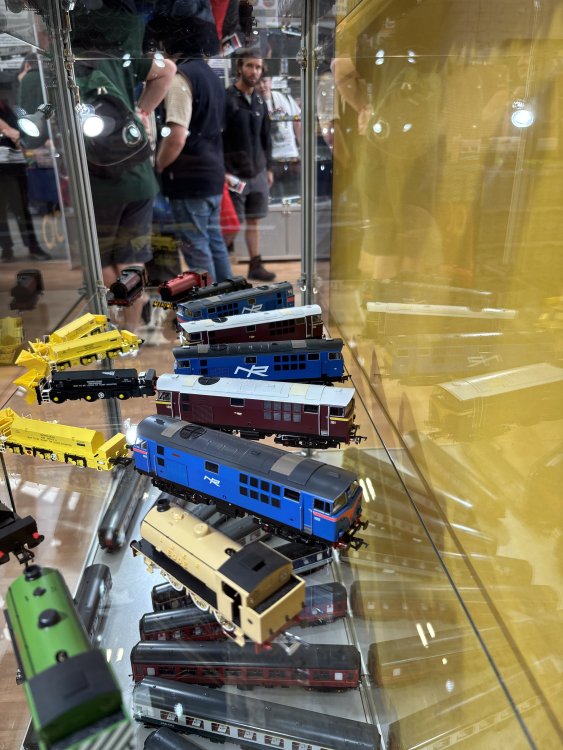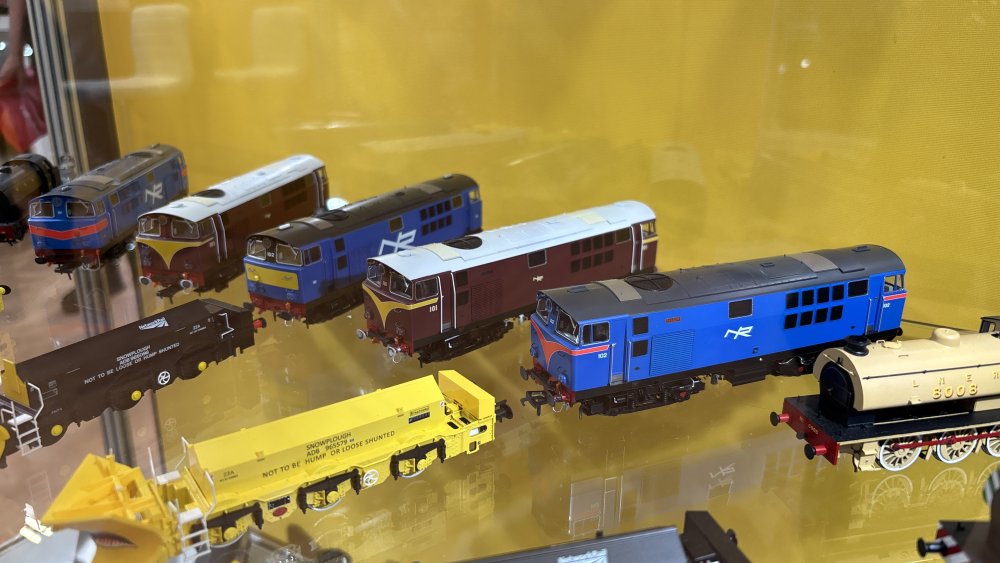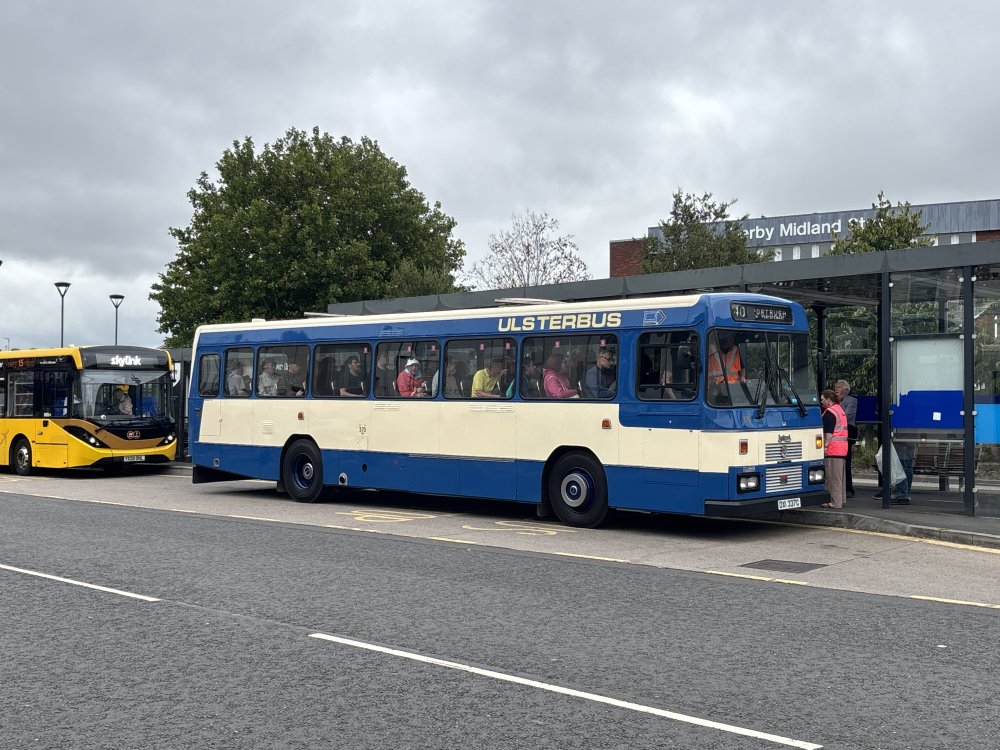
Mol_PMB
Members-
Posts
2,199 -
Joined
-
Last visited
-
Days Won
114
Content Type
Profiles
Forums
Events
Gallery
Blogs
Store
Community Map
Everything posted by Mol_PMB
-
Indeed! Thank you!
-
Just paint a big white NIR logo on the side! (photo from Darren Hall on Flickr)
-
I'm presently working from a list of coaches wired as AEC trailers, which is given in 'Diesel Dawn' (Flanagan) and is credited to Colin Holliday. I suspect the list may have been based on the CIE carriage register - flange lubricator has a copy of the 1969 register (with annotations to update it to the mid-70s) which I hope to cross-reference with the list in 'Diesel Dawn'. I think the lists are accurate for 1969 but may not be complete for the 1950s - for example 1907 is not included (it appears to have lost its control equipment in the 1960s) and diner 343 is not included (because it would have been scrapped before 1969). Anyway, at present the list in 'Diesel Dawn' and photos are the best information available to me. The list includes only three GSWR normal passenger vehicles wired to work with railcars. All are corridor seconds (which would have been corridor thirds before 1956), numbers 1300, 1301, 1308. There was also a variety of old GSWR catering cars, plus one DSER. GSR normal passenger vehicles through-wired are the batch of suburban non-gangwayed open seconds (ex-thirds) 1331-1334, and suburban non-corridor compartment composites 2111-2113. Again there were a couple of GSR catering cars through-wired too. Of course it's possible that there were more old vehicles through-wired which haven't made the list, perhaps including corridor composites. Most of the photos that show GSWR corridor stock in railcar sets seem to be of the corridor side, which was very similar on both the seconds (ex-thirds) and composites.
-
I have another thread in preparation on the intermediates. There were a few GSWR corridor thirds (as shown in your pic above) as well as the old catering cars. Even a couple of non-corridor suburban compartment stock.
-
Finally for now, a group of photos showing tin vans as tail traffic. The luggage version of the tin van (2700-2765) were introduced in 1957 so they post-date most of the photos we've seen upthread. But they dominate the tail traffic from 1959 onwards. 'Railways in Ireland' part 3: DSE/MGW etc (Bairstow) pages 26 and 28 show two photos of a Rosslare-Dublin train formed of a Wedgehead railcar, a GSWR corridor second, an AEC railcar and a tin van as tail traffic. 'Rails Through the West' (Beaumont/Carse) page 83 shows a Limerick-Sligo train on 7th June 1961. The formation is a 3-car set with a GSWR corridor second in the middle, and a tin van as tail traffic. Ernie provides us with a nice colour photo of a 2-car railcar set with a tin van behind, at Limerick on 15th March 1961: The IRRS archive includes three photos from the mid-1960s and the black and tan era, each of which comprise a 3-car set and a tin van on the back. https://www.flickr.com/photos/irishrailwayarchive/53445962837 https://www.flickr.com/photos/irishrailwayarchive/54419866325 https://www.flickr.com/photos/irishrailwayarchive/53447203394 All of these appear to have a CIE corridor second as middle car (1350 to 1355 of this type were through-wired) That's all I've got, but there's quite a variety amongst them. What we need now is some IRM AEC railcars, but I got the impression yesterday that we might have a long wait.
-
Next, a few examples of passenger coaches as tail traffic in the late 1950s into the early 1960s The book 'Cork Bandon & South Coast Railway' (Shepherd) page 38 shows a nice photo at Clonakilty junction in 1957. The same photo also appears at lower quality in 'The Cork, Bandon and South Coast Railway' Vol.3 (Creedon) p67, which also includes another photo of the same train. The formation of the Cork-Bantry train is an AEC railcar, a Park Royal coach, a Wedgehead railcar and finally a CIE corridor second as tail traffic. Of the early 1950s corridor seconds, 1350 to 1355 were through-wired for railcar operation but 1339-1349 are not listed as being fitted to work with the AECs. It's possible that the one being hauled in this photo was not suitably fitted, but there may be another explanation. Also in West Cork, Ernie has a nice pair of photos staed 5th June 1958 with a railcar set strengthened with a pair of 6-wheel coaches as tail traffic. Clearly the Park Royal intermediate was insufficient for the traffic on offer: Working north, Roger Joanes has a nice photo of a train at Clonmel on 28th March 1963, just a pair of railcars and something else coupled behind that is well-hidden behind the footbridge: And so to Sligo on 21st June 1961, with a 3-car set (CIE open second in the middle) hauling another unidentifiable CIE coach as tail traffic. This colour photo shows different shades of green in the rake; the leading car is light green with large numbers on the front: https://www.flickr.com/photos/irishrailwayarchive/53570702493
-
Looking elsewhere in the country in the 1955-1956 period, there is only a book reference for 1955: 'Railways in Ireland' part 4: GS&W (Bairstow) page 71 shows a Sligo-Limerick train at Ennis. A pair of railcars with no intermediate are hauling a bogie passenger coach and 6-wheel passenger brake van. It's a roof shot so a little hard to distinguish the vehicles, but from the long curved rainstrips and the pattern of roof ventilators I think the coach is likely to be one of the 1930s GSR main-line compartment coaches (which were not through-wired for railcar operation). This IRRS photo dated 6th January 1956 shows a lengthy railcar train entering Mullingar. The formation probably includes 4 power cars and several CIE-built passenger coaches between, but tacked on the back is a 6-wheel passenger brake van: https://www.flickr.com/photos/irishrailwayarchive/53498866623 Here's another shot from Ernie showing just a pair of railcars, again with a 6-wheel passenger brake van on the back. This is a Rosslare-Dublin train on 4th June 1956: We've already seen the horsebox at Limerick in the first post, so I won't repeat it here. Again from Ernie and it's 28th August 1956, probably the Sligo-Limerick train at Ennis again. A new Park Royal coach is between the railcars (replacing the GSR coach as tail traffic in the equivalent 1955 photo), but the 6-wheel van is still needed on the back. To complete 1956, there are two more book references to look at: 'Railways in Ireland' part 4: GS&W (Bairstow) p2 also shows the Sligo-Limerick service in August 1956, the same formation as above but with a different railcar leading. 'Rails around Dublin' (Murray) p14 shows a 3-car railcar set (CIE open second 1356-1371 in the middle) with a 6-wheel van on the back, forming the morning Kilkenny-Dublin service on 9th June 1956. Indeed! I decided to limit myself to the CIE railcars for now.
-
Moving on to 1954, AEC railcars were introduced on the West Cork lines. 'The Cork, Bandon and South Coast Railway' Vol.3 (Creedon) page 27 shows the first regular railcar service leaving Albert Quay for Bantry - it is a pair of railcars hauling a 4-wheel goods van. The detail of the van is indistinct. On page 30 of the same book, and also in 1954, there is a photo of a railcar set crossing Chetwynd viaduct. A pair of railcars with a CIE compartment third (1351-1355 series) haul two goods vans. They're not entirely clear but I think they are cattle wagons. Staying with the CB&SCR theme, this photo from Ernie also shows a pair of railcars with a 4-wheel van on the back at Bantry: Whilst this IRRS photo from November 1958 at Clonakilty Junction shows a fitted H van as tail traffic on a railcar set; a CIE compartment second (1351-1355 series) is the middle car in the set: https://www.flickr.com/photos/irishrailwayarchive/54253199453
-
We'll stay in 1953 and move on to a couple of interesting photos posted by Ernie on Flickr. It's 19th August 1953 and 2604 leads a Sligo train. Two vehicles form the tail traffic - a 6-wheel van and something else beyond that which may be a horsebox or fitted goods van: I have not yet identified the middle carriage; I think it is another GSWR catering car. Any ideas? 21st September 1953, and 2616 leads a Rosslare-Dublin train. The middle carriage is one of the open thirds built in 1953 specifically to work with the AEC railcars; these were the 1356-1371 series. The tail traffic on the back is indistinct but interesting. I think the first vehicle is an old 6-wheel travelling post office, complete with net. Beyond that, I think a bogie van or possibly bogie brake third, but unidentifiable at this distance.
-
When the first AEC railcars arrived and were tested in early 1952, the earliest photos I've found show them hauling tail traffic. At this time there may not have been any carriages through-wired to work with them. These two IRRS photos show the pair 2600/2601 hauling a bogie carriage, a 6-wheel van and a 4-wheel van: https://www.flickr.com/photos/irishrailwayarchive/53507783362 https://www.flickr.com/photos/irishrailwayarchive/53509190709 The bogie carriage appears to be GSWR 'Tea car' 838, seen in closeup here a few years earlier. It was one of the old catering cars through-wired for AEC railcar operation but presumably this modification post-dated the photos of it running as tail traffic. https://www.flickr.com/photos/irishrailwayarchive/53509061459 The 6-wheel van looks to be a fairly standard GSWR type passenger brake, and the 4-wheel goods van bringing up the rear must be vac-fitted so it may be a fruit/meat van. By early 1953, a few more railcars were in service and some of the old catering cars had been re-wired to work with them. The photo linked below (from another thread on the forum) appears in 'Chasing the Flying Snail' (Burges) p52 and is dated 2 April 1953. The carriage formed within the railcar set is GSWR diner 343, which is also illustrated in 'Irish Broad Gauge Carriages' (Coakham) p16 - that photo is dated just 6 days later and also shows 343 sandwiched between two AEC railcars. But for this thread, it's not the diner that interests us but the 6-wheel van tacked on the back. Again, this looks to be a fairly standard GSWR type passenger brake. I am not aware that any passenger brake/luggage vans (ancient or modern) were through-wired for use with the AEC railcars, so to cater for an excess of luggage or parcels they had to be tacked on the back.
-
A major advantage of railcar trains is their reversible formation, allowing rapid turn-rounds at termini with no shunting. However, a disadvantage is their relatively fixed formation - it is more difficult to adapt capacity for short-term traffic needs. When the AEC railcars were introduced by CIE, they replaced traditional loco-hauled trains on a very traditionally-operated railway. Staff would have thought nothing of tacking an odd van on the back of a loco-hauled train. This could also be done with a railcar; in the UK it was termed 'tail traffic'. However, tail traffic would become a headache down the line. As well as preventing an easy reversal at the terminus, railcar sets were not easy to shunt with owing to their length - they wouldn't fit in many headshunts, and the driver would have a long walk between the two cabs, or if they remained in one cab they would have very poor visibility in the opposite direction. So you would normally need another loco (or perhaps a horse?) to shunt the tail traffic off the railcar. Nevertheless, CIE's AEC railcars did haul rail traffic, especially in the 1950s. I've found about 30 photos showing a variety of tail traffic and I'll provide links or references in this thread, hopefully as a modelling inspiration. This photo by Ernie shows the North Kerry railcar arriving at Limerick in 1956, with a horsebox as tail traffic: More posts will follow...
-
Very nice to see some transporter wagons modelled. A particular favourite of mine. I have made a small fleet of those for my Om scale Swiss project.
-
I did later have a better chat with AS and got a detailed verbal update on the IRM models, which sounded very promising. Probably best if I leave it to the IRM staff to post an official update here. For the Park Royals relevant to this thread I understand there have been considerable frustrations with the factories in China that have been totally outside IRM’s control and have caused delays, but things are now sorted for quality and delivery is expected around the end of this year. Thanks!
-
I was hoping to see some of the Irish EPs and deco samples on the Accurascale stand at the Greatest Gathering this weekend. Sadly not much Irish stuff to be seen at all. Only a few Hunslets.
-
This is one of the buses on the shuttle to the Greatest Gathering in Derby today Made me think of this thread!
-
Super - thank you
-
My childhood memories of Dublin in the late 80s early 90s are that it was a rough and scary place, if you wanted to park a car you had to pay protection money to one or several gangs if you wanted it to still be there when you returned! Despite the craters in the street I felt safer in Belfast because the heavy police/army presence kept the gangs under control. That’s just my impression as a teenage tourist, it may well be inaccurate or an over-simplification.
-
As someone who commutes regularly by rail through Slaithwaite (pronounced Slawi' (with near-silent t at the end) in true Yorkshire economical style) I think there are quite a few railway operators who would benefit from some training on pronunciation!
-
I agree, I enjoy scratchbuilding, kitbuilding/bashing, and modifying RTR. While I can appreciate the satisfaction of buying a nice model RTR, I don't really feel it's mine until I've made it my own by modifying/detailing/repainting/weathering it in some way. Of course that destroys the nominal value and one could claim that I ruin everything I buy! But I don't buy it to show it off, or to sell it again, I buy it to entertain myself while I make something unique. I also really enjoy researching the prototype, and making models of things that other people don't have and probably never will have if they wait for an RTR version.
-
https://www.accurascale.com/pages/projects Showing delivery later this year on the AS website, though this may not be 100% up to date - some projects such as the Park Royals seem to be delayed but I know thye use various different factories so delays in one project don't necessarily impact another project. I will be in Derby tomorrow and will try to get near the AS/IRM stand to ask about progress. And hopefully not leave too much drool on the display cases
-
On close inspection, this photo from Ernie shows either 1906 or 1907, formed in the middle of a railcar set. Also a nice example of 'tail traffic'. There's almost a pun to be found there. On the wider topic of carriages through-wired as railcar trailers, I think I have found two different clerestory coaches, both catering cars: 343 (8-wheel) and 353 (12-wheel). I am preparing an illustrated diatribe on CIE railcar trailers.
-
https://www.forbes.com/sites/bernardmarr/2024/03/28/generative-ai-and-the-risk-of-inbreeding/
-
Here is the same car, 2633, with the exhaust pipe at the front. This photo shows it in green livery, probably light green as it has the large numerals on the front. So it must have carried this modification for some years at least: https://www.flickr.com/photos/irishrailwayarchive/53445962742
.png.c363cdf5c3fb7955cd92a55eb6dbbae0.png)







